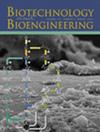与SDF - 1α和TGF - Β3协同作用的微腔水凝胶共培养系统促进软骨形成
IF 3.5
2区 生物学
Q2 BIOTECHNOLOGY & APPLIED MICROBIOLOGY
引用次数: 0
摘要
良好的微环境对软骨损伤的修复具有重要意义。在我们之前的研究中,我们设计了一种共培养系统,将表达转化生长因子(TGF)‐β3的转基因软骨细胞与ATDC5细胞结合,显示出增强的软骨形成作用。本研究基于我们的微腔水凝胶体系构建了基质细胞衍生因子(SDF) - 1α控释的递送平台。随后,我们将其与共培养系统结合,探索SDF - 1α和TGF - β3的释放模式,并研究它们对软骨形成的协同影响。结果表明,在整个培养过程中,SDF - 1α和TGF - β3均能持续有效地从递送系统中释放出来。此外,联合应用SDF - 1α和TGF - β3能够增强细胞增殖活性,如细胞计数试剂盒- 8数据所示。通过实时PCR、Western blot分析和免疫组织化学染色分析,可以证明,它具有协同作用,导致更好的软骨形成。这项研究表明,这种整合了共培养系统和微腔水凝胶的递送系统,在细胞募集和软骨修复方面具有巨大的潜力,可能适用于多种组织的再生医学。本文章由计算机程序翻译,如有差异,请以英文原文为准。
Enhancement of Chondrogenesis by a Microcavitary Hydrogel Coculture System Synergizing With SDF‐1α and TGF‐Β3
A favorable microenvironment is of great significance for the repair of cartilage injury. In our previous study, a coculture system was devised, integrating genetically modified chondrocytes expressing transforming growth factor (TGF)‐β3 with ATDC5 cells, which demonstrated an augmented chondrogenesis effect. In this study, a delivery platform for the controlled release of stromal cell‐derived factor (SDF)‐1α was constructed based on our microcavitary hydrogel system. Subsequently, it was combined with the coculture system to explore the release patterns of SDF‐1α and TGF‐β3 and investigate their synergistic impact on chondrogenesis. The findings indicated that both SDF‐1α and TGF‐β3 could be continuously and efficiently released from the delivery system throughout the culture period. Moreover, the combined application of SDF‐1α and TGF‐β3 was able to enhance cell proliferative activity, as demonstrated by the Cell Counting Kit‐8 data. Synergistically, it led to superior chondrogenesis, as evidenced by real‐time PCR, Western blot analysis, and immunohistochemistry staining assays. This study offers the insight that this delivery system, integrating the coculture system and microcavitary hydrogels, holds substantial potential for cell recruitment and cartilage repair, and may be applicable in regenerative medicine for diverse tissues.
求助全文
通过发布文献求助,成功后即可免费获取论文全文。
去求助
来源期刊

Biotechnology and Bioengineering
工程技术-生物工程与应用微生物
CiteScore
7.90
自引率
5.30%
发文量
280
审稿时长
2.1 months
期刊介绍:
Biotechnology & Bioengineering publishes Perspectives, Articles, Reviews, Mini-Reviews, and Communications to the Editor that embrace all aspects of biotechnology. These include:
-Enzyme systems and their applications, including enzyme reactors, purification, and applied aspects of protein engineering
-Animal-cell biotechnology, including media development
-Applied aspects of cellular physiology, metabolism, and energetics
-Biocatalysis and applied enzymology, including enzyme reactors, protein engineering, and nanobiotechnology
-Biothermodynamics
-Biofuels, including biomass and renewable resource engineering
-Biomaterials, including delivery systems and materials for tissue engineering
-Bioprocess engineering, including kinetics and modeling of biological systems, transport phenomena in bioreactors, bioreactor design, monitoring, and control
-Biosensors and instrumentation
-Computational and systems biology, including bioinformatics and genomic/proteomic studies
-Environmental biotechnology, including biofilms, algal systems, and bioremediation
-Metabolic and cellular engineering
-Plant-cell biotechnology
-Spectroscopic and other analytical techniques for biotechnological applications
-Synthetic biology
-Tissue engineering, stem-cell bioengineering, regenerative medicine, gene therapy and delivery systems
The editors will consider papers for publication based on novelty, their immediate or future impact on biotechnological processes, and their contribution to the advancement of biochemical engineering science. Submission of papers dealing with routine aspects of bioprocessing, description of established equipment, and routine applications of established methodologies (e.g., control strategies, modeling, experimental methods) is discouraged. Theoretical papers will be judged based on the novelty of the approach and their potential impact, or on their novel capability to predict and elucidate experimental observations.
 求助内容:
求助内容: 应助结果提醒方式:
应助结果提醒方式:


